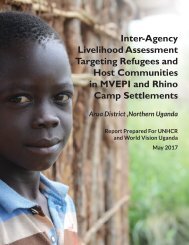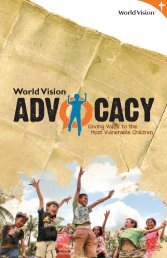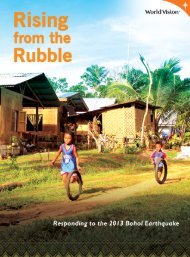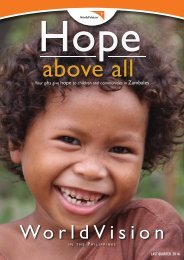SAENER18 Months On Report FINAL (NON-HiRES)
You also want an ePaper? Increase the reach of your titles
YUMPU automatically turns print PDFs into web optimized ePapers that Google loves.
Introduction<br />
Preface<br />
Southern Africa Region has long been vulnerable to disasters such as droughts and floods. Some<br />
of the earliest recorded occurrences were as early as 1902. By 2000, the intensity, severity<br />
and frequency were exacerbated across the region. During the same period, the governments<br />
started organised responses to the increased threat. Nonetheless, the government response<br />
continues to be overwhelmed by the increasing severity of each new drought. The 2015/16 El<br />
Niño induced drought was recorded as the most intense to affect the region in the past three<br />
decades . Crops, livestock and fresh water bodies were badly affected with cascading effects to<br />
livelihoods, jobs wellbeing and the general economies of the region.<br />
World Vision had been monitoring our internally generated early warning systems prior to<br />
the drought and was able to make timely decisions at the highest level which empowered<br />
the Southern Africa Regional Office to mount a commensurate response to the drought. We<br />
embarked on mobilising partners and highlighting the magnitude of the problem. However,<br />
the dwindling resources especially the Private Non Sponsorship funds constrained the<br />
operationalisation of the regional response coordination unit (RCU). Nonetheless, our efforts<br />
raised sufficient funds to implement urgently needed lifesaving interventions in the national<br />
offices. We also worked closely with the Regional Inter Agency Standing Committee (RIASCO)<br />
and the various governments to profile the humanitarian situation as well as coordinate<br />
activities to maximise the impact of the intervention.<br />
Through the various organisational networks, we were able to attract and deploy skilled staff<br />
to the various national offices at minimal cost. Most of these were acquired on secondment<br />
due to the short and temporary nature of the assignment. However, this enabled us to save on<br />
staffing costs and the savings channelled into direct programming.<br />
Notwithstanding the successful response, key questions remain unanswered and desire<br />
further investigation to inform policies and improve the delivery of humanitarian assistance.<br />
The questions are:<br />
• Are the governments and humanitarians addressing the key drivers of recurring<br />
droughts? If not, why and what can they do to address them?<br />
• How relevant are our models and capacities to the context? How long will they withstand<br />
the increasing assault by droughts?<br />
I’m not suggesting that these questions are exhaustive and/or<br />
answering them will give us the ‘magic bullet’ to resolve the<br />
drought induced challenges. Nonetheless, it will give us a new<br />
outlook on the regional context. Sadly, we know it is not only<br />
a matter of ‘íf’ but ‘when’ the next drought will strike- this is<br />
our new reality.<br />
Joseph K. Kamara<br />
Regional Director, Humanitarian & Emergency Affairs<br />
1<br />
Manatsa et. al, 2008. The superior influence of Darwin Sea level pressure anomalies over ENSO as a simple drought predictor for Southern Africa.<br />
Theoretical and applied climatology, 92(1), pp.1-14.<br />
2<br />
OCHA. RIASCO Action Plan for Southern Africa: Response Plan for the El Niño Induced Drought in Southern Africa, May 2016- April 2017. 2016.<br />
Southern Africa El Niño Emergency Response (SAENER)<br />
18 MONTHS ON REPORT 9










